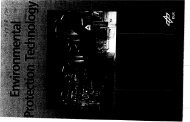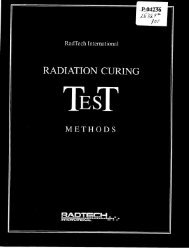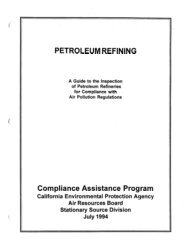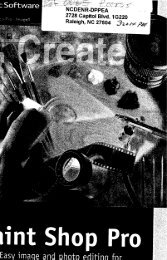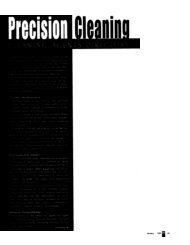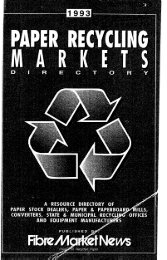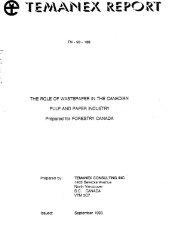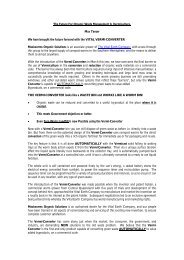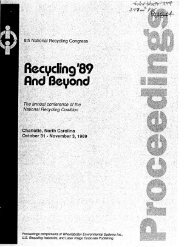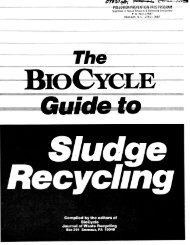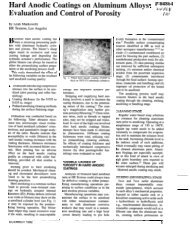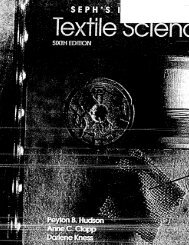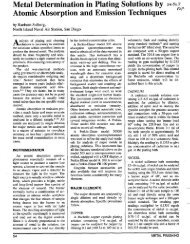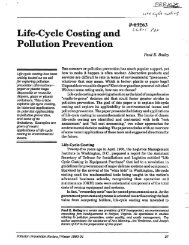Electronic Parts/Guidelines - infoHouse
Electronic Parts/Guidelines - infoHouse
Electronic Parts/Guidelines - infoHouse
You also want an ePaper? Increase the reach of your titles
YUMPU automatically turns print PDFs into web optimized ePapers that Google loves.
Landf////ng: Currently plastics account for 7% by Weight and 20% by volume of our municipal landfill.<br />
Since, 15.9% of these plastics are polystyrene, 1.1% by weight and 3.2% by volume of landfill mate-<br />
rials is thought to be polystyrene. Recycling efforts stand to reduce these figures even further.<br />
7.5.2.4 Recommendations: Polystyrene is a material whose packaging properties offer many<br />
values Including stability, cushioning effects, and little Weight. While it has been dubbed a villain In our<br />
landfills, Its envlronmental Impacts appear to be in the areas of hazardous waste and air emissions<br />
rather than in solid waste disposal.<br />
Post consumer recycling efforts could reduce demand for virgin styrene and thus source reduce some<br />
of the hazardous wastes involved in styrenetpolystyrene manufacturing.<br />
Polystyrene recycling processes, especially those involving re- expansion of the material, have low tol-<br />
erance for contamination. Therefore, packaging professionals can facilitate polystyrene recycling with<br />
packaging designs that ensure its integrity as a post-consumer recycling material.<br />
Continued efforts by the chemical industry to reduce hazardous waste should be encouraged, partic-<br />
ularly by key customers such as electronics industry packaging professionals who specify polystyrene<br />
packaging components.<br />
7.5.3 Environmental Impact of Polyethylene Foam<br />
Polyethylene is a commonly used material In a large percentage of electronic packaging designs. PE<br />
is used in several forms inClUding bags, sheeting, rigid trays and expanded foams. These foams may<br />
include roll stock in thin grades and semi rigid plank products. This report will deal specifically with<br />
expanded PE foams. Most issues and recommendations apply equally to polypropylene foam as well.<br />
PE foam is normally bought by the end users from a local distributor or fabricator. These companies in<br />
turn purchase the product from one of the manufacturers who provide the product in bundles, plank or<br />
bun form. The fabricators and distributors add value by converting or supplying the material in smaller<br />
quantities or in a form such as custom shaped cushions, die cut pieces, pouches or in combination<br />
with other materials.<br />
7.5.3.1 Resources: Ethylene is a by-product of the petroleum industry, and like all petroleumbased<br />
materials, is derived from non-renewable resources. Nearly all PE foam is manufactured from<br />
virgin resin today. Most manufacturers are developing products with recycled content. Blowing agents<br />
used in the expansion process for the PE foam are typically either HCFCs or hydrocarbons. Other<br />
materlals are used in small quantities as coloring agents or aids in the manufacturing process.<br />
7.5.3.2 Manufacturing issues: PE foam is manufactured in one process which takes PE resin,<br />
blends it with a blowing agent under heat and pressure, extrudes the mlxture through a die. The result<br />
after extrusion is escape of the blowing agent and the final product of PE foam with millions of small<br />
air cells which provide the CUShiOning, Insulation and surface protection. The escaped blowing agent<br />
may be released to the outside atmosphere or captured and reused through a closed manufacturing<br />
system. This recapture system is expensive to implement and maintain. Its installation should be<br />
encouraged to reduce harmful air emissions and preserve natural resources.<br />
Energy Use: This varies depending on the manufacturing system used and is generally from running<br />
the extruder. Very little energy is used in the converting process which consists of cutting, perforating<br />
andtor laminating.<br />
Weter Use: Some water is used for cooling on some extruders. It is generally unpolluted and can be<br />
easily reused or returned to the municipal water system.<br />
ufe cycle Assessment 61



